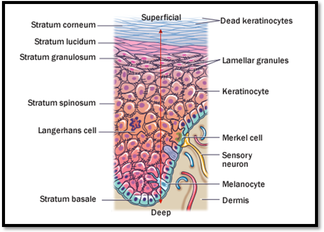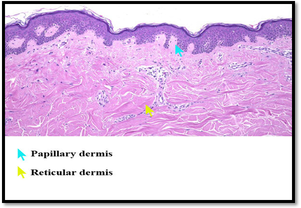
The human skin is known as the integument. Our skin is the largest and the heaviest part of the body which comprises of approximately 12-15% of the body weight and it covers 1 .5 - 2m2 of surface area. It also protects the body from different kinds of damages like abrasion from outside and loss of water. The Integumentary System also includes nails, the hair, projections from the skin and the receptors which help the skin to be a sensory organ. The Integumentary System protects, separates and distinguishes the organism from its surroundings.
The human skin comprises of three major layers of tissue:
Epidermis
Dermis
Hypodermis
The superficial protective layer of the skin is known as the epidermis. The epidermis is the top most layer of the skin, composed of epithelial cells. The epidermis does not contain any blood vessels. It basically forms the outermost layer providing a barrier to the outside environment. The main function of the epidermis is absorption of the vital nutrients, protection and homeostasis (the tendency of a living organism or a cell to maintain internal body balance). The other remaining parts of the body contain only four layers. The layers of the epidermis are as follows:
-
Stratum basale: The stratum basale comprises of single layer of cells that are in contact with the dermis. The structure of the epidermis is composed of four types of cells that include Melanocyctes, Keratinocytes, Merkel cells and the Langerhan’s cells. Keratinocytes, which produces keratin, is the major cell of the epidermis. Keratin is a fibrous and a water-proofing protein that helps in protection. Majority of the skin on the body is keratinized, which means they are waterproofed. The lining of the skin inside our mouth is the only part of the skin of the body that is non-keratinized. Non keratinized cells allow the water to stay on top of their structure. The epidermises of the palms and the soles have five layers as these areas are more exposed to friction. The Melanocyctes are specialized epithelial cells that produce the pigment known as melanin, which acts as a protective barrier to the ultraviolet radiation. The Merkel cells are scattered and rare in comparison with the keratinocyctes and melanocyctes. These receptor cells help in touch reception. The Langerhans cell are scattered throughout the stratum basale and are basically cells that absorb bacteria and other scattered foreign fragments.
-
Stratum spinosum: They contain many stratified layers of cell. It has a spiny appearance as the spine like extension arises from the keratinocyctes. They also contain dendritic cells that help the body against pathogens. They provide flexibility and strength to the skin.
-
Stratum granulosum: they contain three to four flat rows of cells that are filled with keratohyalin, which is a chemical precursor to keratin. They also form a barrier between the deeper layer of the epidermis and the surface cells. To waterproof the skin, the stratum granulosum also produce lipid filled vesicles that basically release a glycolipid (lipids with carbohydrate attached, provide energy) by exocytosis (process by which the contents of a cell vacuole are released to the exterior through fusion of the vacuole membrane with the cell).
-
Stratum lucidum: they are also present in the finger tips, palm of the hands and soles of the feet. The stratum lucidum contains the precursor of keratin. The organelles (any of a number of organized or specialized structures within a living cell), nuclei and the cell membranes are not visible in the cells of stratum lucidum. They contain three to five layers of flat and clear dead cells.
-
Stratum corneum: the stratum corneum is made of 25 to 30 layers of flat, scale like cells. Every day from the skin surface thousands of these dead cells shed and are replaced by new ones from the deeper layers. This basic surface layer is cornified and it is the actual layer that protects the skin. Cornification is basically brought on by keratinisation, the process of drying and flattening of the stratum corneum. It also acts a barrier to protect the skin from heat, water, light, chemical and bacteria.

In comparison with the epidermis, the dermis is much deeper and thicker. The skin tone and the lines of tension in the skin are provided by the elastic and collagenous fibers present within the dermis. More elastic fibers are present in the dermis of a younger person, than in comparison with an elderly person. With increasing age, the number of elastic fibers gradually decreases. In the dermis the extensive network of blood vessels provide nourishment to the living portion of the epidermis. The dermis also contains oil-secreting glands, nerve endings, sweat glands and hair follicles.
The dermis is composed of two layers:
-
Stratum papillarosum: the upper layer of the dermis is called the stratum papillarosum. It is basically in contact with the epidermis and it accounts for about one-fifth of the whole dermis. Many projections known as the papillae extend from the upper portion of the dermis into the epidermis. They basically form the base for the friction ridges on the toes and fingers. They also contain capillaries that feed the epidermis. They also have the touch and free nerve endings for different sensations like cold, pain, tickle, heat and itching.
-
Stratum reticularosum: the thicker and the deeper layer of the dermis are known as the stratum reticularosum. The fibers situated within this layer are dense and are arranged regularly to form a flexible and a tough meshwork. Though it can be stretched very far as can be seen with obese people and pregnant women, it can also cause tearing sometimes. The repair of this area leaves a white streak, also known as the stretch mark. Stretch marks are commonly found on the thighs, abdomen, breasts and buttocks. The dermis also provides strength and elasticity to the skin.

The thickest and the innermost layer of the skin is Hypodermis. It is also known as subcutaneous tissue. The hypodermis consists of areolar and adipose tissue. Hypodermis basically insulates our body from cold temperatures and provides shock absorption. The nutrients and energy are stored by the fat cells of the hypodermis. In the palms of the hands, buttocks and in the soles of the feet, the hypodermis is the thickest; but as we age it begins to waste away and contributes to thinning of the skin.
G Kowledge of | 0 Comments >>
0 Comments
Leave Comment
Your email address will not be published. Required fields are marked.